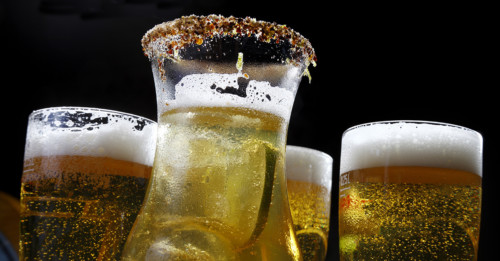You’d think after brewers spend painstaking weeks and months brewing and fermenting their beers, maybe even a while aging them, we’d leave well enough alone—simply pour them into the appropriate serving glass (maybe a holy chalice?), bow in respect, and consume.
Not quite. The beer world has always had a bit of a coloring-outside-the-lines vibe about it, and even the world of finely crafted beers is fair game. Which is why, as craft beer has continued its sudsy explosion, that abundance of new product has also yielded a freedom to experiment, resulting in innovations in the field of the “beer cocktail.”
Beer cocktails are exactly what they sound like: some style of beer mixed with other ingredients to produce a finished, balanced drink. While most traditional cocktails are made with hard liquor as a base, beer cocktails don’t necessarily have to feature anything but beer.
In fact, some of the earliest beer mixed drinks are just beer: the “Black and Tan” is made by pouring a pale ale or lager halfway up a pint glass and filling the rest of the glass with a porter or stout (poured over the back of a spoon so that the darker beer doesn’t mix but rests on top of the lighter beer). The “Snakebite” layers lager and hard cider in exactly the same way, while the Black Velvet incorporates Champagne, the bubbly an oddly perfect bedfellow for rich stout.
Liquor does eventually get into the mix with beer cocktails. Take the Boilermaker. Sure, some may not consider a Boilermaker a “cocktail” in the refined sense of the term, but in the basic sense of beer-plus-something else equals a finished drink, it fits. The something else in this case is a shot of whiskey, dropped directly into your pint, the whole thing consumed in one heroic chug session.
Then there are drinks like the Michelada (beer, lime and tomato or Clamato juice, optional hot sauces), the Shandy (beer and lemonade), and the Radler (like a Shandy, swapping lemon soda for lemonade). Drinks like these are what you might call beer cocktails 1.0—simpler prototypes that endure because they’re (very) good. But as craft beer and mixology have each gotten more complex, so have beer cocktails. And that isn’t entirely surprising, given the array of flavors and textures beer offers a bartender. Think of the richness of a stout: coffee, toffee and toasty flavors that might play well into bourbon. Or the pine and grapefruit of an IPA, which practically beg for a chance to play side by side with juniper and citrus-forward gins.
When it comes to making beer cocktails at home, your best bet is something simple—don’t go out and buy a cabinet’s worth of liquors, bitters, and fresh fruit to accompany your beer. Remember, beer is already brewed to have a lot going on. That’s why so many early beer mixed drinks are fairly simple: complexity can sometimes turn into cacophony. Build around the flavors of your beer and you’ll have a solid, so to speak, beer cocktail.
